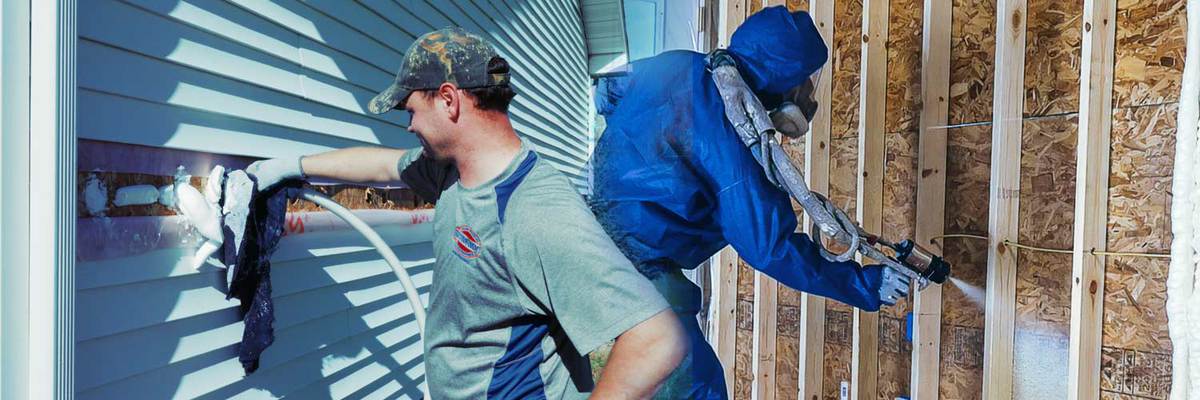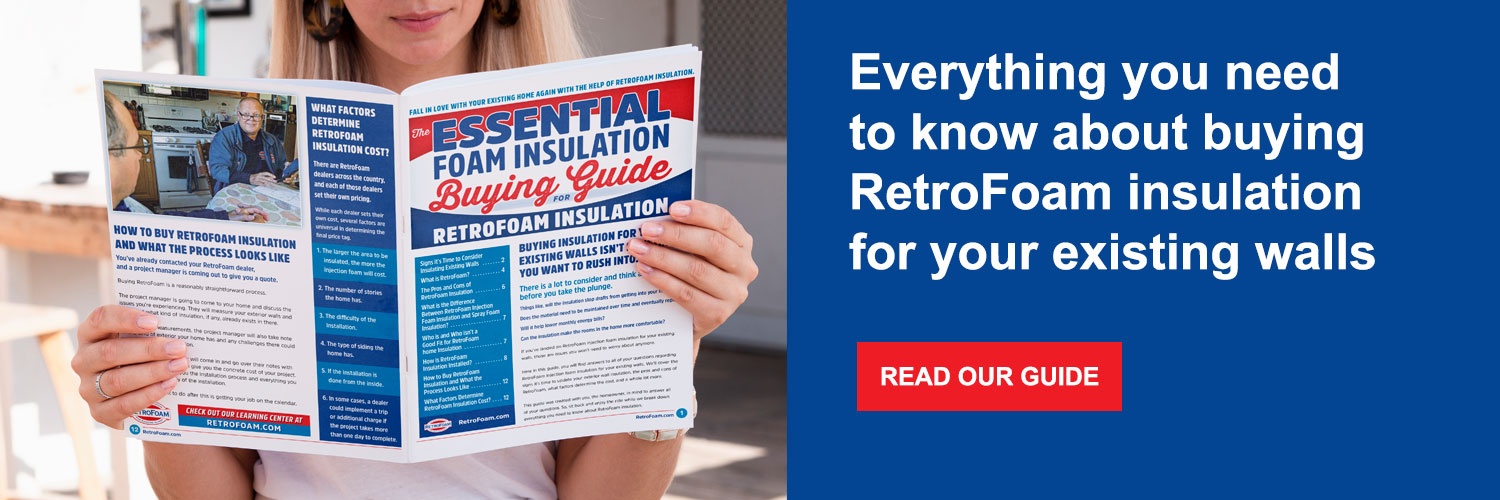What is the Difference Between RetroFoam Injection Foam and Spray Foam Insulation?
injection foam insulation | spray foam insulation | RetroFoam insulation | FAQs


What is the Difference Between RetroFoam and Spray Foam? (Quick Answer)
The quick answer is that it really comes down to how they are installed because both materials create an air seal that makes homes more comfortable and energy-efficient. RetroFoam is an injection foam that is injected into enclosed cavities like existing walls. Spray foam insulation is sprayed into open cavities like attics, crawl spaces, rim joists, and pole barns.
Now let's take a deep dive.
There is some confusion in the foam insulation world, and it all stems from the phrase “spray foam.”
The issue is that some people use the term “spray foam insulation” for any sort of foam insulation, like injection foam or even the can foam you buy at the local hardware store. It may not seem like a huge deal, but it leads to some real confusion.
For example, some spray foam insulations off-gas due to their Volatile Organic Compounds, but RetroFoam doesn’t off-gas at all. Another issue is when people talk about expansion rates of spray foam because RetroFoam doesn’t expand at all.
So, what is the difference between RetroFoam injection foam and spray foam insulation? It comes down to how the two materials are installed and where.
This article will talk about what injection and spray foam insulation are and how they’re installed to help clear up any confusion.
What is RetroFoam Insulation?
RetroFoam home insulation is an injection foam that is used to insulate existing exterior walls.
This injection foam is Class One Fire Rated and completely safe to have in your home. It doesn’t off-gas, and it doesn’t promote the growth of mold and mildew like traditional insulations can.
RetroFoam is a tripolymer based resin that is mixed with a foaming agent and water to create the insulation. It is mixed inside the installer’s trailer and injected into the exterior walls.
Let’s talk a little bit more about that installation process.
RetroFoam Home Insulation Installation Process
Injection foam insulation is installed in the enclosed cavities of existing exterior walls.
It may seem like the process will create a huge mess in your home, but the injection foam can be installed from the outside, so your drywall doesn’t have to be torn down.
The old insulation in the walls, like fiberglass, doesn’t need to be removed before the installation. This is because the injection foam compresses it as it is filling the cavity.
If there is cellulose in the walls, the installer will try to remove as much of it as possible before injecting the foam. This is done because the cellulose won’t compress like the fiberglass and, in some instances, will act as a barrier in the wall.
The exterior of the home can change the installation process.
A home with aluminum or vinyl siding will require a piece of the siding to be removed all around the house so a hole can be drilled into each stud cavity.
The injection foam is mixed in the trailer and runs through a hose with a nozzle to the exterior. The nozzle is placed inside the hole so the foam can be pumped inside the cavity.
Once the foam insulation is injected, the holes are filled with a plug, and the siding is replaced.
Brick exteriors are handled slightly differently.
Smaller holes are drilled through the mortar joints between every stud at the top, middle, and bottom. When the cavities are full, the holes are re-mortared.
Lastly, wood siding is a little different and a little trickier to work with.
If the siding can be removed, then the same process for vinyl and aluminum is followed.
If the siding can’t be removed, holes must be drilled through the wood siding. After the foam has been injected, the holes are filled with plugs.
What is Spray Foam Insulation?
Spray foam insulation is installed in any open cavities, like attics, crawl spaces, rim joists, and the open wall cavities of newly built homes and pole barns.
Most spray foams are made when two liquids combine, causing a chemical reaction to form the polyurethane foam.
Now, how spray foam insulation is installed.
Spray Foam Insulation Installation Process
Before spray foam can be installed in an existing home, the old insulation must be removed.
This is done so the spray foam has a nice, clean space to adhere to and can completely fill the area where it is sprayed. This is a crucial difference between spray foam and injection foam insulation -- the spray product actually adheres to the area where it’s sprayed. In contrast, injection foam doesn’t stick to the wall cavity.
The prep for spray foam takes more time because it is installed inside the home. So, furniture and other items should be moved out of the area or moved to the room’s center. The installer will cover everything in plastic, including the floors and surfaces, to make sure no spray foam gets on them.
Once all of the prep work is done, the foam is mixed on-site in the trailer and sprayed into the cavity.
Creating an Air Seal with Foam Insulation
Now you have a better understanding of the difference between injection foam and spray foam insulation, so let’s talk about something they have in common – an air seal.
Essentially, spray foam and RetroFoam injection foam insulation differ, but they perform in the same way. Both materials create an air seal. They just do it in different places.
Sealing your home’s entire building envelope will make it much more comfortable and save you money on your monthly heating and cooling costs in the process.
Spray Foam Insulation in Existing Walls with RetroFoam
So, you see, RetroFoam insulation isn’t a spray foam at all but allows you to insulate existing walls with foam insulation without a major home remodel.
If you want to learn more about RetroFoam, check out the Dealer Finder on our website to find a RetroFoam installer in your area.
Related Articles
How Do RetroFoam Installers Know the Cavity is Full When Insulating Existing Walls?
Who is Not a Good Fit for RetroFoam Home Insulation?
Ten Home Problems That May Warrant Adding RetroFoam Insulation to Exterior Walls
About Amanda Emery
Amanda previously has worked as a breaking news and crime reporter, TV news producer, and editor. As a journalist, she has won several awards from The Society of Professional Journalists - Detroit Chapter and the Michigan Press Association. Amanda uses her experience as a journalist to write content that will help educate homeowners on foam insulation benefits. When Amanda isn’t writing, she’s spending time with her husband Chris, daughter Lilith-Maeve, and rescued huskies Danger and Wendigo. She also loves knitting, making art, and cooking.


